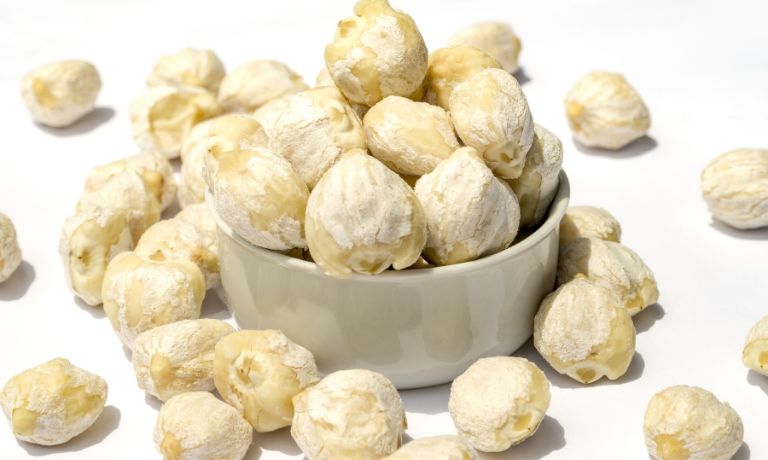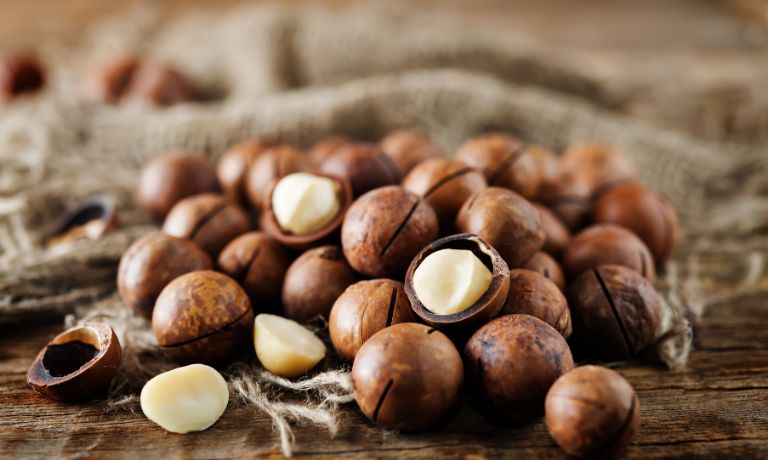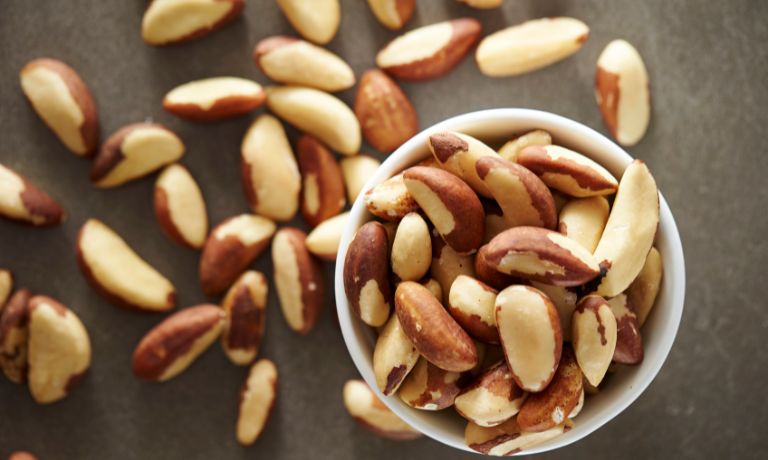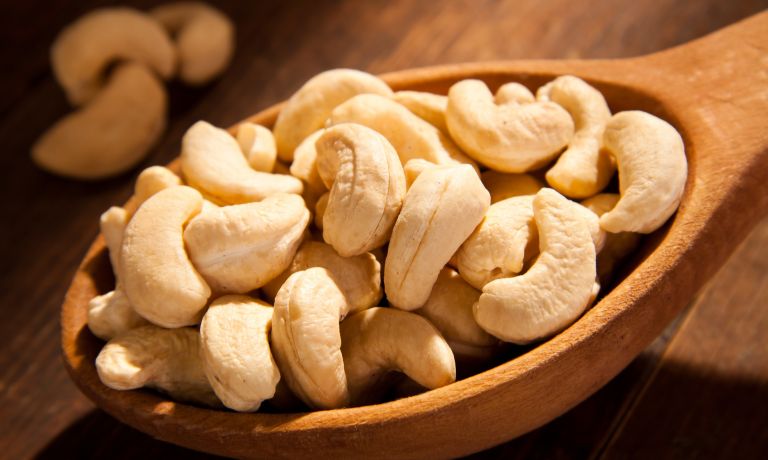Searching for a good substitute for candlenuts in recipes?
If you’ve been trying to get the perfect nutty flavor without the unique texture of candlenuts, then look no further!
Our comprehensive guide will provide detailed information on nutrition contents, best substitutes for candlenuts, how to use them in our favorite dishes – plus plenty more.
Let’s explore the vast options available when it comes to finding a great alternative for these traditional nuts.
What Are Candlenuts?
Candlenuts are tree nuts found in Southeast Asia, Indonesia, and the Philippines.
They have a hard outer shell and a light yellow kernel inside that has a slightly sweet taste with slightly bitter undertones.
Candlenuts are most commonly used to thicken sauces and curries, as well as being used as an ingredient in some desserts.
They can also be dry-roasted and ground into a paste for flavoring dishes or added to soups for extra flavor and texture.
Candlenuts provide a unique nutty flavor often found in traditional Southeast Asian cuisine.
When using candlenuts, it’s important to buy the freshest nuts possible; otherwise, they can quickly become rancid.
Additionally, because the oil from candlenuts is highly flammable, it’s important to be careful when handling them.

Substitutes For Candlenuts
If you’re looking for a substitute for candlenuts, there are a few options you can consider.
Macadamia Nuts
Macadamia nuts are a type of tree nut native to the Australian continent. They have a hard, thick shell and an oily texture.
The nuts can be eaten raw or roasted, and they also make a great substitute for candlenuts in cooking.
They are also rich in essential vitamins and minerals, including vitamin A, zinc, magnesium, and iron.
In addition to being a healthy alternative to traditional candlenuts in dishes such as curries or sauces, macadamia nuts can be used in baking applications such as cakes, cookies, and even ice cream.
They have a unique flavor that makes them stand out from other nuts in a variety of dishes.

Brazil Nuts
Brazil nuts are native to South America and are the fruit of a large tree found primarily in Brazil, Venezuela, Colombia, Peru and Bolivia.
They have a mild, sweet flavor with a hint of bitterness, making them popular for snacking and cooking.
The nut is also high in protein and other essential minerals such as calcium, iron, magnesium and zinc.
When used in cooking, their mild flavor and creamy texture can make a great substitute for candlenuts, which may be hard to find or expensive.
Brazil nuts can also be used in many dishes such as salads, desserts and other baked goods.
As a bonus, Brazil nuts are also an environmentally friendly choice since they are grown sustainably without the use of chemicals or pesticides.

Pine Nuts
Pine nuts, which are also known as pinon nuts or pignolia, come from pine trees and are the edible seeds of certain species.
They have a sweet and nutty flavor that makes them popular as an ingredient in salads, pesto sauces, pasta, and desserts.
Pine nuts can be used as a substitution for candlenuts in various dishes, as their mild flavor easily complements other ingredients.
The nuts are an excellent source of protein and they provide essential minerals like magnesium, iron, and zinc.
They can also be used as a garnish or topping for bread, salads, and more.

Cashews
Cashews are a type of nut that is native to the Caribbean and South America.
Cashews have a sweet, mild flavor that makes them ideal for adding to both savory and sweet dishes.
They can be used in many different ways, from making nut butter and milk to adding a crunchy texture to salads and other cooked dishes.
They are also lower in calories and fat than most nuts, making them a healthier option for those looking to reduce their intake of saturated fats.
Cashews can be soaked and blended into sauces or used as an added crunchy topping for salads and other dishes.
Furthermore, they are a great source of plant-based proteins, healthy fats, vitamins and minerals, such as magnesium and manganese.

Hazelnuts
Hazelnuts, also known as filberts, are a type of nut native to many parts of Europe and Asia.
They have a unique flavor that makes them popular in a variety of dishes.
While they can’t replace nuts like almonds or walnuts in recipes due to their distinct taste, hazelnuts can be used as an alternative for candlenuts in certain recipes.
Candlenuts are a type of nut indigenous to the Philippines, Indonesia, and other parts of Southeast Asia.
They have an extremely strong flavor that can overpower many dishes if used in large quantities.
By using hazelnuts instead, you can get the nutty flavor without any overpowering taste.
Hazelnuts can also be used as an alternative to candlenuts in desserts.
They’re particularly popular when added to chocolate-based recipes, such as chocolate truffles or brownies.

Almonds
Almonds are a popular type of tree nut that are native to parts of China, the Middle East, and Europe.
They have a crunchy yet buttery texture with a sweet flavor, making them ideal for baking and snacking.
They are also commonly used as a substitute for candlenuts in cooking because they offer similar properties when it comes to texture and flavor.
Almonds are a source of essential vitamins and minerals such as calcium, magnesium, iron, and zinc.
They also have healthy fats and protein to help promote satiety, making them a great ingredient for all types of recipes.
With their mild flavor and crunchy texture, almonds are a great alternative to candlenuts when cooking.
Plus, they’re safer and more nutritious than candlenuts, making them a smarter choice for health-conscious cooks.

Palm Oil
Palm oil is an edible oil derived from the mesocarp (reddish pulp) of the fruit of the oil palms.
It is commonly used in cooking, especially for frying.
Palm oil has a high smoke point and can be a great substitution for candlenuts due to its similar flavor profile.
Additionally, palm oil contains more saturated fat than candlenuts, making it a more suitable replacement for dishes that require high-heat cooking.
Many chefs prefer to use palm oil as opposed to other oils due to its neutral flavor, making it versatile enough for use in baking and desserts as well.
Palm oil is also highly resistant to oxidation and rancidity compared to other vegetable oils, which makes it a great choice for dishes that require longer cooking times.

Coconut Oil
Coconut oil is a type of fat extracted from the flesh of mature, dried coconuts.
It has a slightly nutty flavor and can be used as an alternative to traditional fats and oils in baking or cooking.
Coconut oil has been used for centuries in Asian cultures for both culinary and therapeutic purposes.
This type of oil can be used as a substitute for candlenuts in cooking.
The oil has a mild nutty flavor and can be used in place of traditional fats and oils, such as butter or vegetable oil.
Its high smoke point makes it suitable for sautéing, frying, or baking, while its medium-chain fatty acids are beneficial to health.
Additionally, coconut oil is vegan-friendly, making it a great choice for plant-based recipes.

FAQs
Are Macadamia And Candlenut The Same Thing?
No, Macadamia and Candlenut are not the same thing.
Macadamia is a species of tree in the family Proteaceae that produces edible nuts, while Candlenut is a type of tree in the family Myristicaceae that yields an edible oily nut known as Kukui Nut.
The two nuts have different flavors and textures, with Macadamia nuts being creamy, sweet and buttery, while Candlenuts have a more pungent flavor and texture.
What Flavor Does Candlenut Have?
Candlenut has a rich, nutty flavor with hints of sweetness and a slightly earthy aroma.
It is similar to macadamia nuts or other tropical nuts like cashews.
What Can You Use Instead Of Candlenuts To Make Curry?
If you don’t have access to candlenuts, there are several options for substituting them in a curry.
You can use macadamia nuts for an nutty, earthy flavor; ground almonds or cashews for a creamier texture; or sunflower seeds for a mild crunch.
Conclusion
Candlenuts are a traditional ingredient found in Southeast Asian cuisine, but due to their robust flavor and potential for allergic reactions, they can be difficult to use.
Thankfully, there are many options available to substitute for candlenuts that can provide similar flavors and textures with fewer risks associated.
From pine nuts and cashews to hazelnuts, almonds, palm oil, and coconut oil, there are a variety of substitutes to choose from when cooking dishes that call for candlenuts.
Each one offers its own advantages in terms of flavor, texture, nutrition, and more.
Consider giving some of these options a try the next time you want to create Southeast Asian-inspired dishes without using candlenuts.

